lights BMW 5 SERIES 2011 Owners Manual
[x] Cancel search | Manufacturer: BMW, Model Year: 2011, Model line: 5 SERIES, Model: BMW 5 SERIES 2011Pages: 304, PDF Size: 10.54 MB
Page 12 of 304
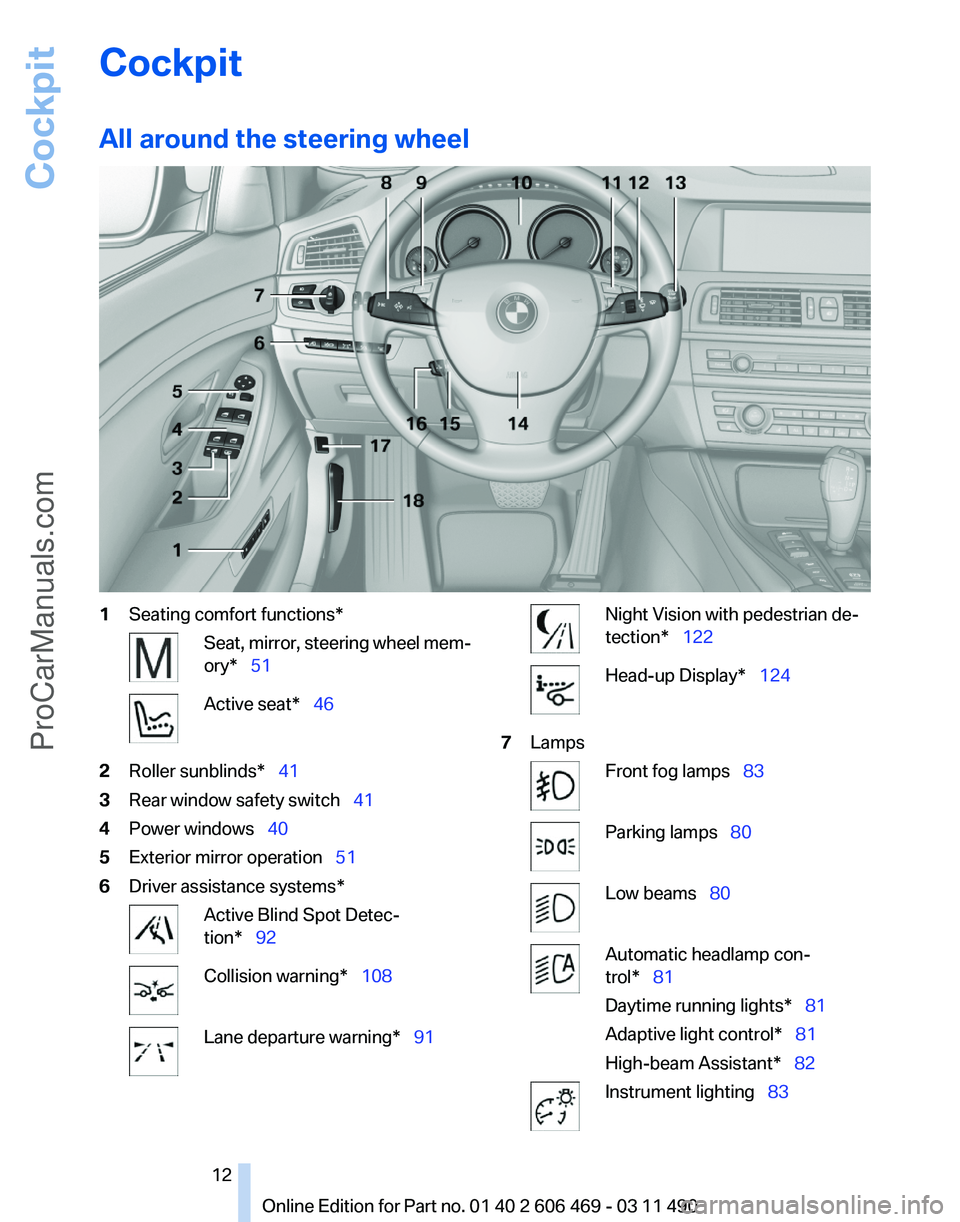
Cockpit
All around the steering wheel
1
Seating comfort functions* Seat, mirror, steering wheel mem‚Äź
ory*‚Äā‚ÄÖ51
Active seat*‚Äā‚ÄÖ46
2 Roller sunblinds*‚Äā‚ÄÖ41
3 Rear window safety switch‚Äā‚ÄÖ 41
4 Power windows‚Äā‚ÄÖ 40
5 Exterior mirror operation‚Äā‚ÄÖ51
6 Driver assistance systems* Active Blind Spot Detec‚Äź
tion*‚Äā‚ÄÖ92
Collision warning*‚Äā‚ÄÖ108
Lane departure warning*‚Äā‚ÄÖ91 Night Vision with pedestrian de‚Äź
tection*‚Äā‚ÄÖ122
Head-up Display*‚Äā‚ÄÖ
124
7 Lamps Front fog lamps‚Äā‚ÄÖ
83 Parking lamps‚Äā‚ÄÖ
80 Low beams‚Äā‚ÄÖ80
Automatic headlamp con‚Äź
trol*‚Äā‚ÄÖ81
Daytime running lights*‚Äā‚ÄÖ81
Adaptive light control
*‚Äā‚ÄÖ81
High-beam Assistant*‚Äā‚ÄÖ82 Instrument lighting‚Äā‚ÄÖ83
Seite 12
12 Online Edition for Part no. 01 40 2 606 469 - 03 11 490
Cockpit
ProCarManuals.com
Page 31 of 304
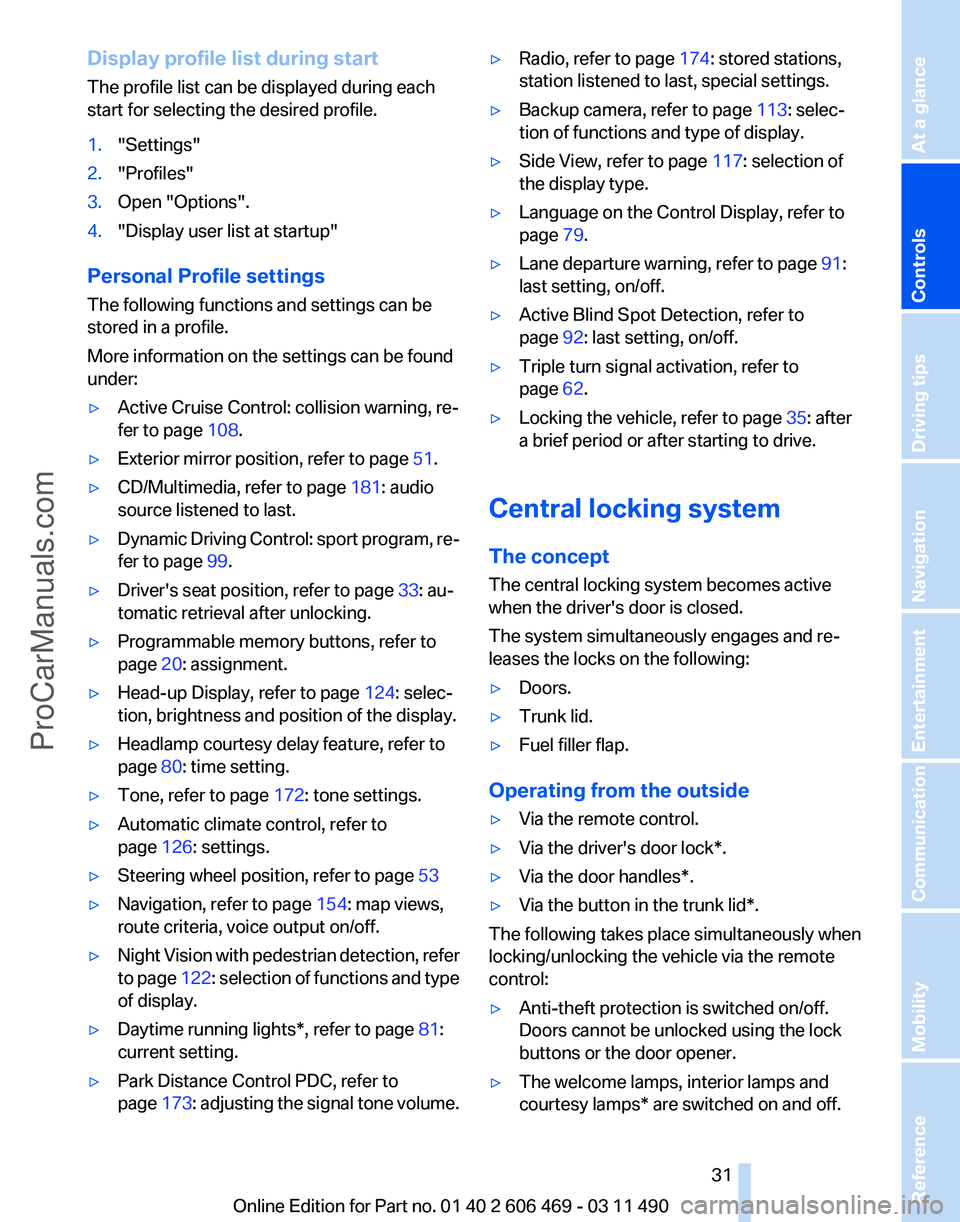
Display profile list during start
The profile list can be displayed during each
start for selecting the desired profile.
1.
"Settings"
2. "Profiles"
3. Open "Options".
4. "Display user list at startup"
Personal Profile settings
The following functions and settings can be
stored in a profile.
More information on the settings can be found
under:
‚Ė∑ Active Cruise Control: collision warning, re‚Äź
fer to page 108.
‚Ė∑ Exterior mirror position, refer to page 51.
‚Ė∑ CD/Multimedia, refer to page 181: audio
source listened to last.
‚Ė∑ Dynamic Driving Control: sport program, re‚Äź
fer to page 99.
‚Ė∑ Driver's seat position, refer to page 33: au‚Äź
tomatic retrieval after unlocking.
‚Ė∑ Programmable memory buttons, refer to
page 20: assignment.
‚Ė∑ Head-up Display, refer to page 124: selec‚Äź
tion, brightness and position of the display.
‚Ė∑ Headlamp courtesy delay feature, refer to
page 80: time setting.
‚Ė∑ Tone, refer to page 172: tone settings.
‚Ė∑ Automatic climate control, refer to
page 126: settings.
‚Ė∑ Steering wheel position, refer to page 53
‚Ė∑ Navigation, refer to page 154: map views,
route criteria, voice output on/off.
‚Ė∑ Night Vision with pedestrian detection, refer
to
page 122: selection of functions and type
of display.
‚Ė∑ Daytime running lights*, refer to page 81:
current setting.
‚Ė∑ Park Distance Control PDC, refer to
page 173:
adjusting the signal tone volume. ‚Ė∑
Radio, refer to page 174: stored stations,
station listened to last, special settings.
‚Ė∑ Backup camera, refer to page 113: selec‚Äź
tion of functions and type of display.
‚Ė∑ Side View, refer to page 117: selection of
the display type.
‚Ė∑ Language on the Control Display, refer to
page 79.
‚Ė∑ Lane departure warning, refer to page 91:
last setting, on/off.
‚Ė∑ Active Blind Spot Detection, refer to
page 92: last setting, on/off.
‚Ė∑ Triple turn signal activation, refer to
page 62.
‚Ė∑ Locking the vehicle, refer to page 35: after
a brief period or after starting to drive.
Central locking system
The concept
The central locking system becomes active
when the driver's door is closed.
The system simultaneously engages and re‚Äź
leases the locks on the following:
‚Ė∑ Doors.
‚Ė∑ Trunk lid.
‚Ė∑ Fuel filler flap.
Operating from the outside
‚Ė∑ Via the remote control.
‚Ė∑ Via the driver's door lock*.
‚Ė∑ Via the door handles*.
‚Ė∑ Via the button in the trunk lid*.
The following takes place simultaneously when
locking/unlocking the vehicle via the remote
control:
‚Ė∑ Anti-theft protection is switched on/off.
Doors cannot be unlocked using the lock
buttons or the door opener.
‚Ė∑ The welcome lamps, interior lamps and
courtesy lamps* are switched on and off.
Seite 31
31Online Edition for Part no. 01 40 2 606 469 - 03 11 490
Reference Mobility Communication Entertainment Navigation Driving tips
Controls At a glance
ProCarManuals.com
Page 40 of 304
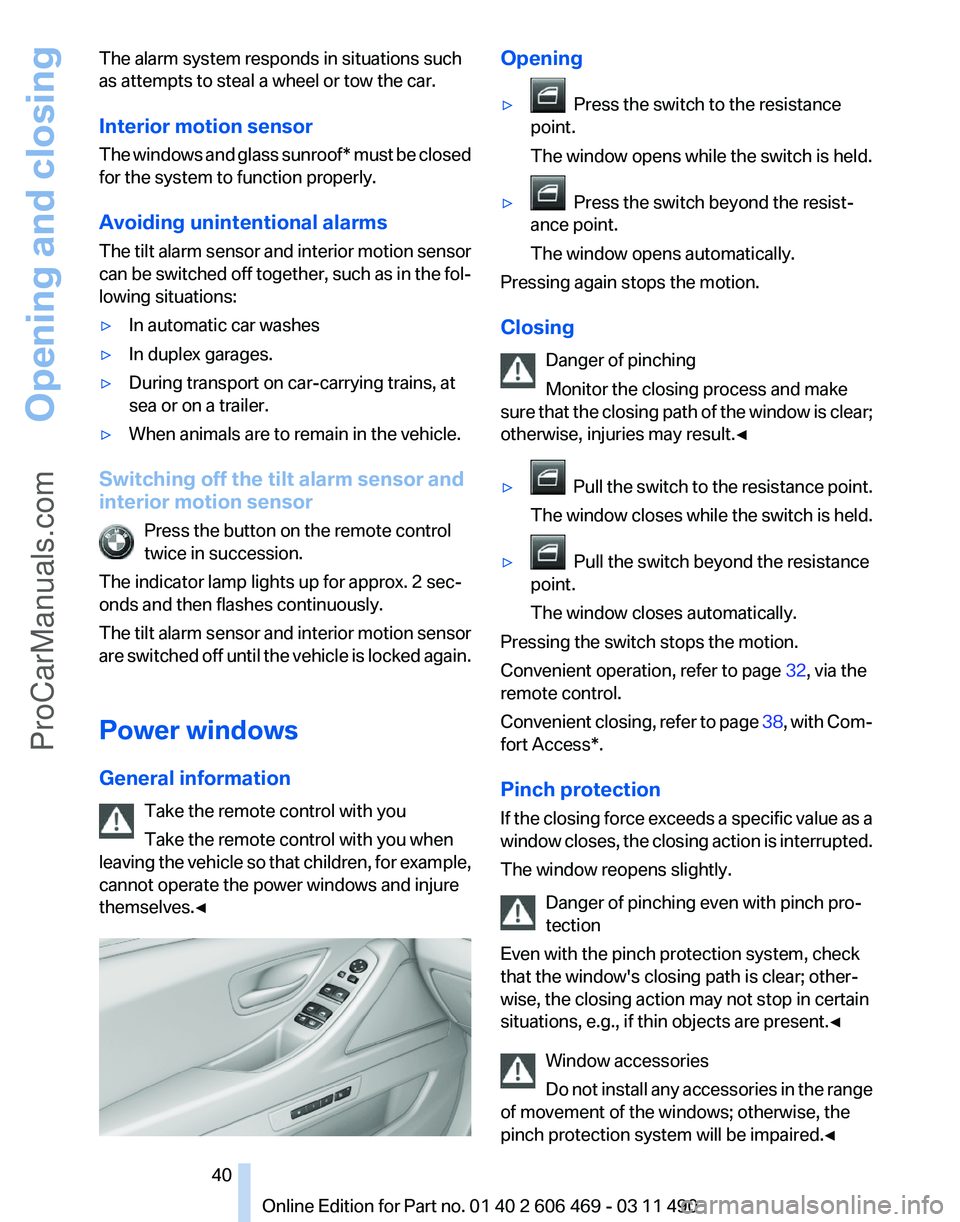
The alarm system responds in situations such
as attempts to steal a wheel or tow the car.
Interior motion sensor
The
windows and glass sunroof* must be closed
for the system to function properly.
Avoiding unintentional alarms
The tilt alarm sensor and interior motion sensor
can be switched off together, such as in the fol‚Äź
lowing situations:
‚Ė∑ In automatic car washes
‚Ė∑ In duplex garages.
‚Ė∑ During transport on car-carrying trains, at
sea or on a trailer.
‚Ė∑ When animals are to remain in the vehicle.
Switching off the tilt alarm sensor and
interior motion sensor Press the button on the remote control
twice in succession.
The indicator lamp lights up for approx. 2 sec‚Äź
onds and then flashes continuously.
The
tilt alarm sensor and interior motion sensor
are switched off until the vehicle is locked again.
Power windows
General information
Take the remote control with you
Take the remote control with you when
leaving the vehicle so that children, for example,
cannot operate the power windows and injure
themselves.‚óÄ Opening
‚Ė∑
Press the switch to the resistance
point.
The window opens while the switch is held.
‚Ė∑ Press the switch beyond the resist‚Äź
ance point.
The window opens automatically.
Pressing again stops the motion.
Closing
Danger of pinching
Monitor the closing process and make
sure
that the closing path of the window is clear;
otherwise, injuries may result.‚óÄ
‚Ė∑ Pull
the switch to the resistance point.
The window closes while the switch is held.
‚Ė∑ Pull the switch beyond the resistance
point.
The window closes automatically.
Pressing the switch stops the motion.
Convenient operation, refer to page 32, via the
remote control.
Convenient
closing, refer to page 38, with Com‚Äź
fort Access*.
Pinch protection
If the closing force exceeds a specific value as a
window closes, the closing action is interrupted.
The window reopens slightly.
Danger of pinching even with pinch pro‚Äź
tection
Even with the pinch protection system, check
that the window's closing path is clear; other‚Äź
wise, the closing action may not stop in certain
situations, e.g., if thin objects are present.‚óÄ
Window accessories
Do not install any accessories in the range
of movement of the windows; otherwise, the
pinch protection system will be impaired.‚óÄ Seite 40
40 Online Edition for Part no. 01 40 2 606 469 - 03 11 490
Opening and closing
ProCarManuals.com
Page 41 of 304
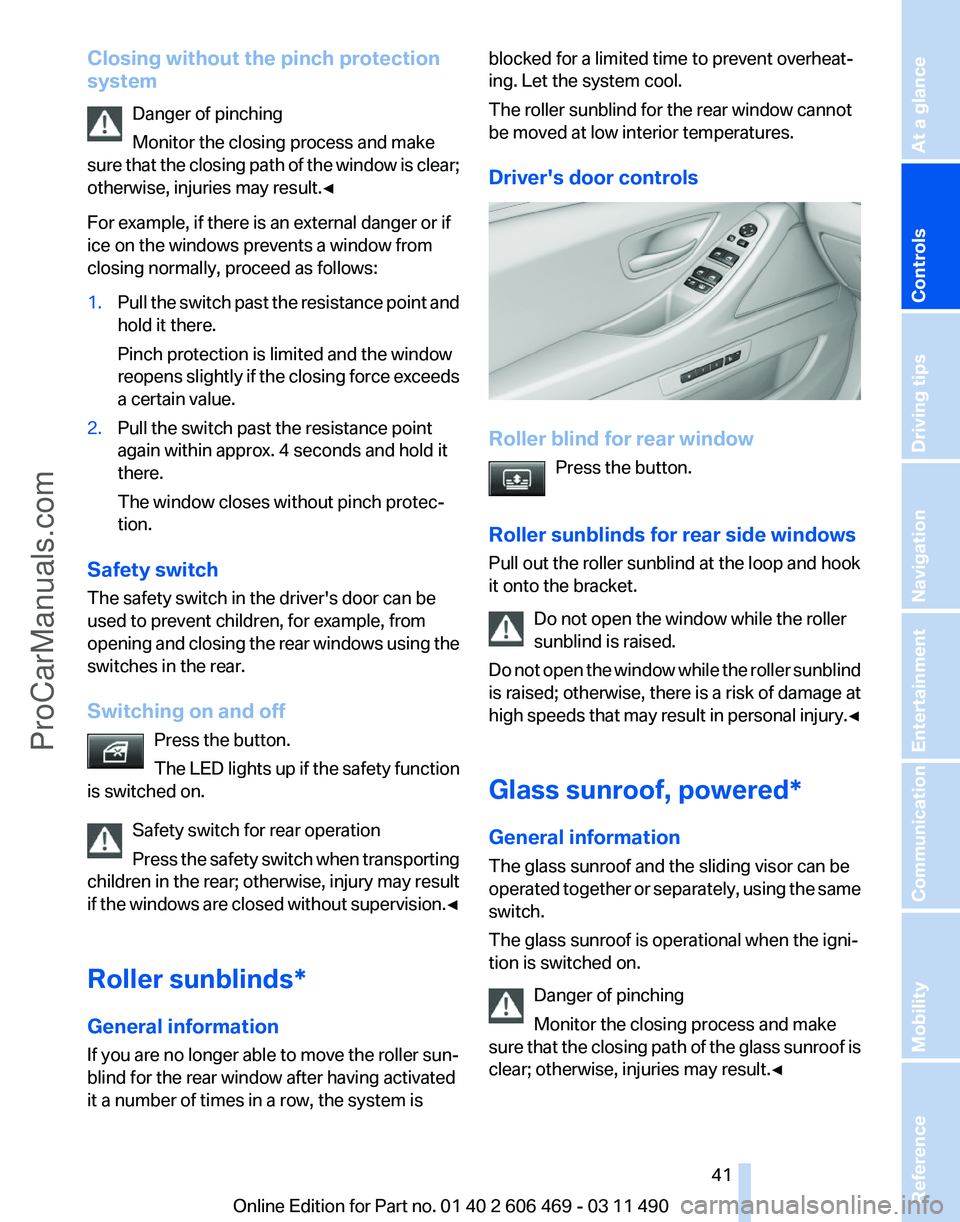
Closing without the pinch protection
system
Danger of pinching
Monitor the closing process and make
sure
that the closing path of the window is clear;
otherwise, injuries may result.‚óÄ
For example, if there is an external danger or if
ice on the windows prevents a window from
closing normally, proceed as follows:
1. Pull the switch past the resistance point and
hold it there.
Pinch protection is limited and the window
reopens
slightly if the closing force exceeds
a certain value.
2. Pull the switch past the resistance point
again within approx. 4 seconds and hold it
there.
The window closes without pinch protec‚Äź
tion.
Safety switch
The safety switch in the driver's door can be
used to prevent children, for example, from
opening
and closing the rear windows using the
switches in the rear.
Switching on and off
Press the button.
The LED lights up if the safety function
is switched on.
Safety switch for rear operation
Press the safety switch when transporting
children in the rear; otherwise, injury may result
if the windows are closed without supervision.‚óÄ
Roller sunblinds*
General information
If you are no longer able to move the roller sun‚Äź
blind for the rear window after having activated
it a number of times in a row, the system is blocked for a limited time to prevent overheat‚Äź
ing. Let the system cool.
The roller sunblind for the rear window cannot
be moved at low interior temperatures.
Driver's door controls
Roller blind for rear window
Press the button.
Roller sunblinds for rear side windows
Pull out the roller sunblind at the loop and hook
it onto the bracket. Do not open the window while the roller
sunblind is raised.
Do
not open the window while the roller sunblind
is raised; otherwise, there is a risk of damage at
high speeds that may result in personal injury.‚óÄ
Glass sunroof, powered*
General information
The glass sunroof and the sliding visor can be
operated together or separately, using the same
switch.
The glass sunroof is operational when the igni‚Äź
tion is switched on.
Danger of pinching
Monitor the closing process and make
sure that the closing path of the glass sunroof is
clear; otherwise, injuries may result.‚óÄ Seite 41
41Online Edition for Part no. 01 40 2 606 469 - 03 11 490
Reference Mobility Communication Entertainment Navigation Driving tips
Controls At a glance
ProCarManuals.com
Page 46 of 304
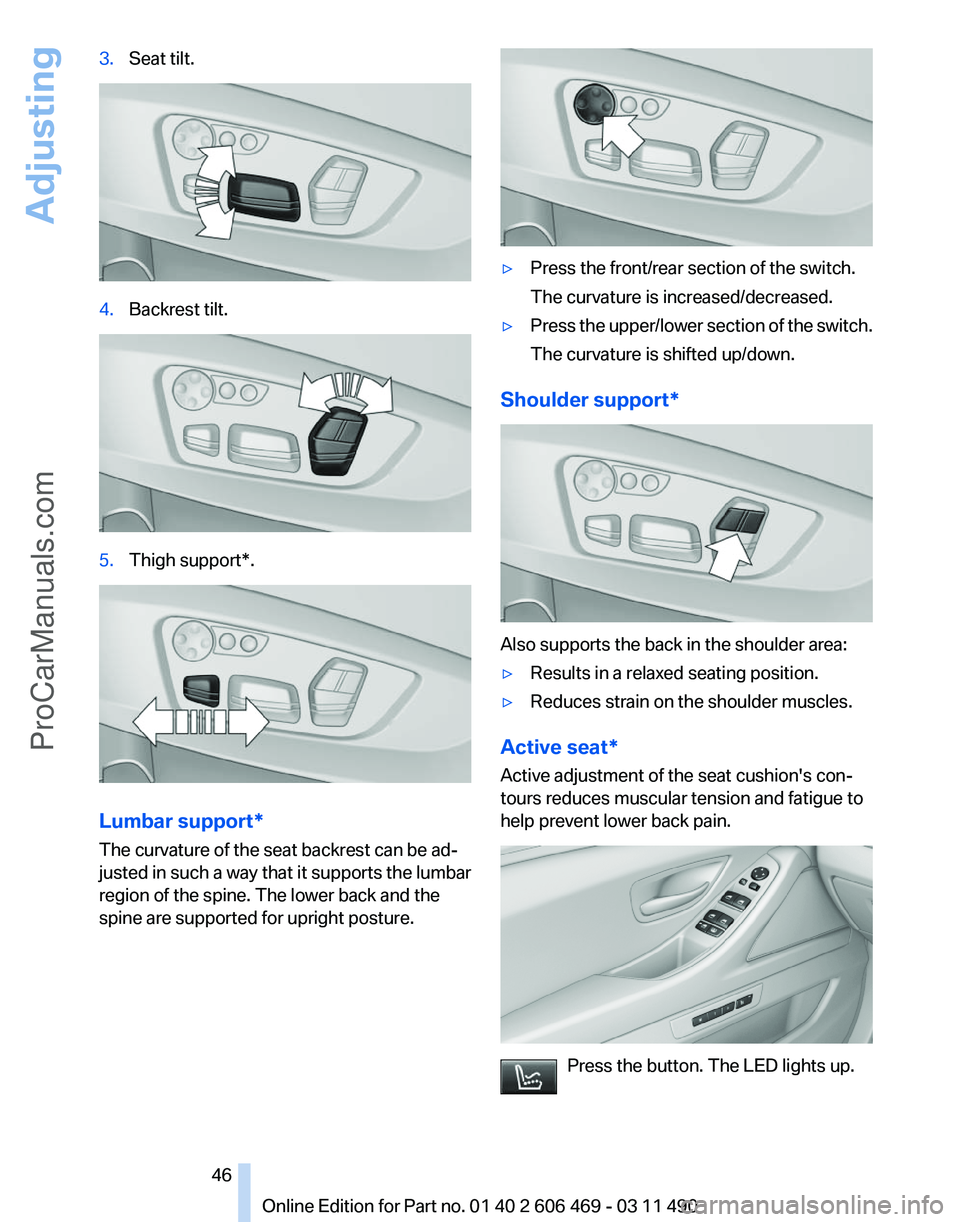
3.
Seat tilt. 4.
Backrest tilt. 5.
Thigh support*. Lumbar support*
The curvature of the seat backrest can be ad‚Äź
justed in such a way that it supports the lumbar
region of the spine. The lower back and the
spine are supported for upright posture. ‚Ė∑
Press the front/rear section of the switch.
The curvature is increased/decreased.
‚Ė∑ Press the upper/lower section of the switch.
The curvature is shifted up/down.
Shoulder support* Also supports the back in the shoulder area:
‚Ė∑
Results in a relaxed seating position.
‚Ė∑ Reduces strain on the shoulder muscles.
Active seat*
Active adjustment of the seat cushion's con‚Äź
tours reduces muscular tension and fatigue to
help prevent lower back pain. Press the button. The LED lights up. Seite 46
46 Online Edition for Part no. 01 40 2 606 469 - 03 11 490Adjusting
ProCarManuals.com
Page 48 of 304
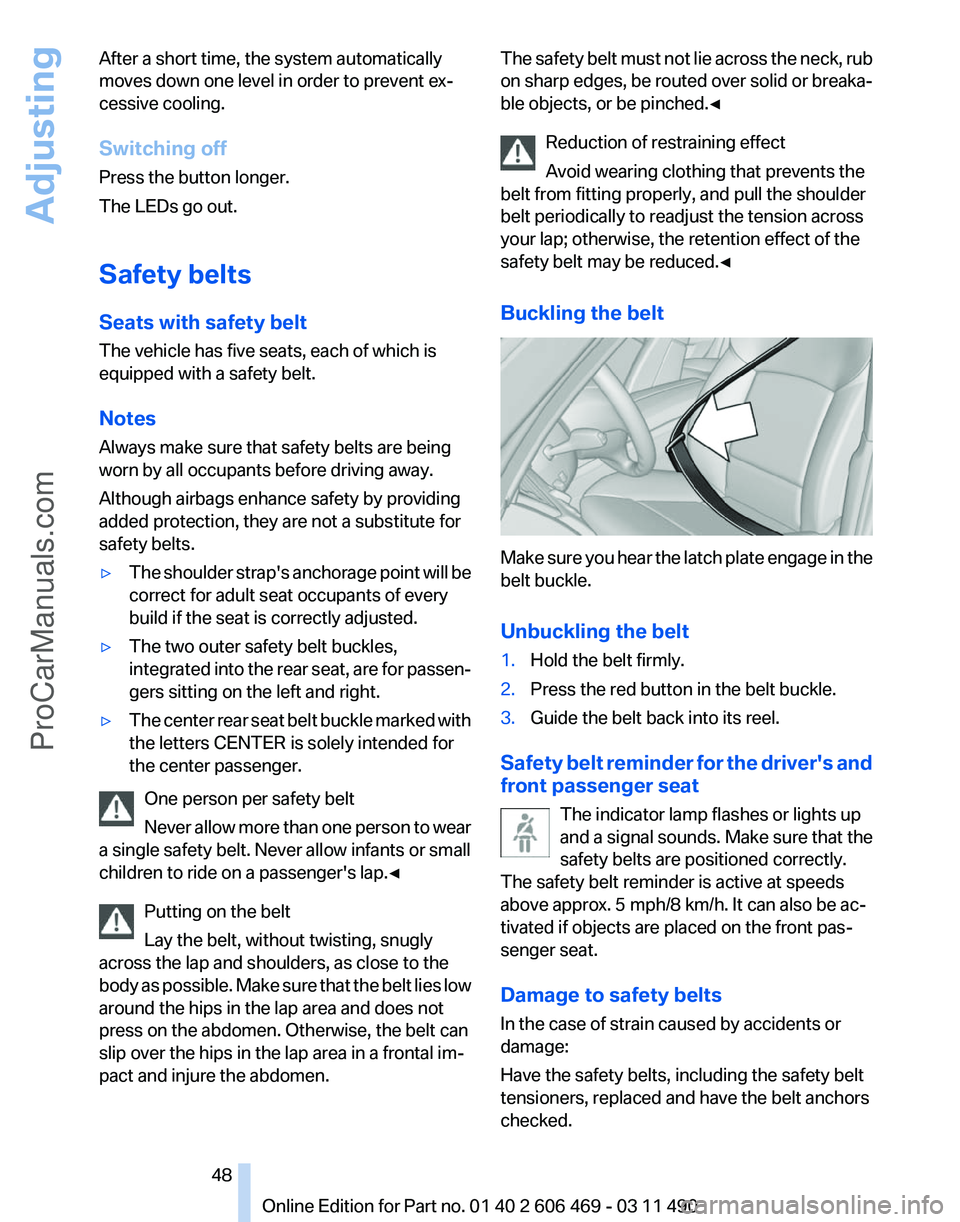
After a short time, the system automatically
moves down one level in order to prevent ex‚Äź
cessive cooling.
Switching off
Press the button longer.
The LEDs go out.
Safety belts
Seats with safety belt
The vehicle has five seats, each of which is
equipped with a safety belt.
Notes
Always make sure that safety belts are being
worn by all occupants before driving away.
Although airbags enhance safety by providing
added protection, they are not a substitute for
safety belts.
‚Ė∑
The shoulder strap's anchorage point will be
correct for adult seat occupants of every
build if the seat is correctly adjusted.
‚Ė∑ The two outer safety belt buckles,
integrated
into the rear seat, are for passen‚Äź
gers sitting on the left and right.
‚Ė∑ The center rear seat belt buckle marked with
the letters CENTER is solely intended for
the center passenger.
One person per safety belt
Never
allow more than one person to wear
a single safety belt. Never allow infants or small
children to ride on a passenger's lap.‚óÄ
Putting on the belt
Lay the belt, without twisting, snugly
across the lap and shoulders, as close to the
body as possible. Make sure that the belt lies low
around the hips in the lap area and does not
press on the abdomen. Otherwise, the belt can
slip over the hips in the lap area in a frontal im‚Äź
pact and injure the abdomen. The safety belt must not lie across the neck, rub
on
sharp edges, be routed over solid or breaka‚Äź
ble objects, or be pinched.‚óÄ
Reduction of restraining effect
Avoid wearing clothing that prevents the
belt from fitting properly, and pull the shoulder
belt periodically to readjust the tension across
your lap; otherwise, the retention effect of the
safety belt may be reduced.‚óÄ
Buckling the belt Make sure you hear the latch plate engage in the
belt buckle.
Unbuckling the belt
1.
Hold the belt firmly.
2. Press the red button in the belt buckle.
3. Guide the belt back into its reel.
Safety belt reminder for the driver's and
front passenger seat The indicator lamp flashes or lights up
and a signal sounds. Make sure that the
safety belts are positioned correctly.
The safety belt reminder is active at speeds
above approx. 5 mph/8 km/h. It can also be ac‚Äź
tivated if objects are placed on the front pas‚Äź
senger seat.
Damage to safety belts
In the case of strain caused by accidents or
damage:
Have the safety belts, including the safety belt
tensioners, replaced and have the belt anchors
checked. Seite 48
48 Online Edition for Part no. 01 40 2 606 469 - 03 11 490
Adjusting
ProCarManuals.com
Page 51 of 304
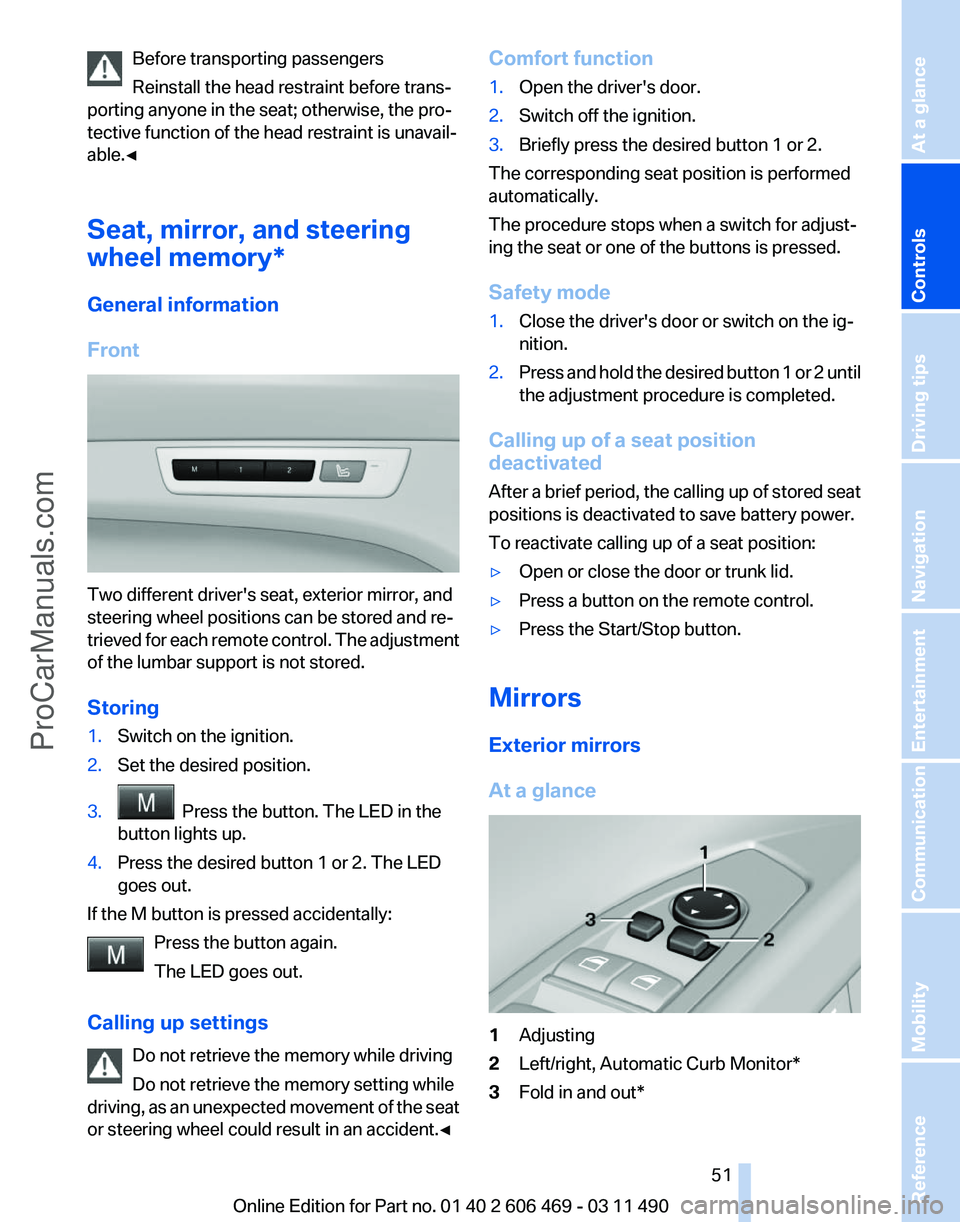
Before transporting passengers
Reinstall the head restraint before trans‚Äź
porting anyone in the seat; otherwise, the pro‚Äź
tective function of the head restraint is unavail‚Äź
able.‚óÄ
Seat, mirror, and steering
wheel memory*
General information
Front Two different driver's seat, exterior mirror, and
steering wheel positions can be stored and re‚Äź
trieved
for each remote control. The adjustment
of the lumbar support is not stored.
Storing
1. Switch on the ignition.
2. Set the desired position.
3. Press the button. The LED in the
button lights up.
4. Press the desired button 1 or 2. The LED
goes out.
If the M button is pressed accidentally: Press the button again.
The LED goes out.
Calling up settings Do not retrieve the memory while driving
Do not retrieve the memory setting while
driving,
as an unexpected movement of the seat
or steering wheel could result in an accident.‚óÄ Comfort function
1.
Open the driver's door.
2. Switch off the ignition.
3. Briefly press the desired button 1 or 2.
The corresponding seat position is performed
automatically.
The procedure stops when a switch for adjust‚Äź
ing the seat or one of the buttons is pressed.
Safety mode
1. Close the driver's door or switch on the ig‚Äź
nition.
2. Press and hold the desired button 1 or 2 until
the adjustment procedure is completed.
Calling up of a seat position
deactivated
After
a brief period, the calling up of stored seat
positions is deactivated to save battery power.
To reactivate calling up of a seat position:
‚Ė∑ Open or close the door or trunk lid.
‚Ė∑ Press a button on the remote control.
‚Ė∑ Press the Start/Stop button.
Mirrors
Exterior mirrors
At a glance 1
Adjusting
2 Left/right, Automatic Curb Monitor*
3 Fold in and out*
Seite 51
51Online Edition for Part no. 01 40 2 606 469 - 03 11 490
Reference Mobility Communication Entertainment Navigation Driving tips
Controls At a glance
ProCarManuals.com
Page 53 of 304
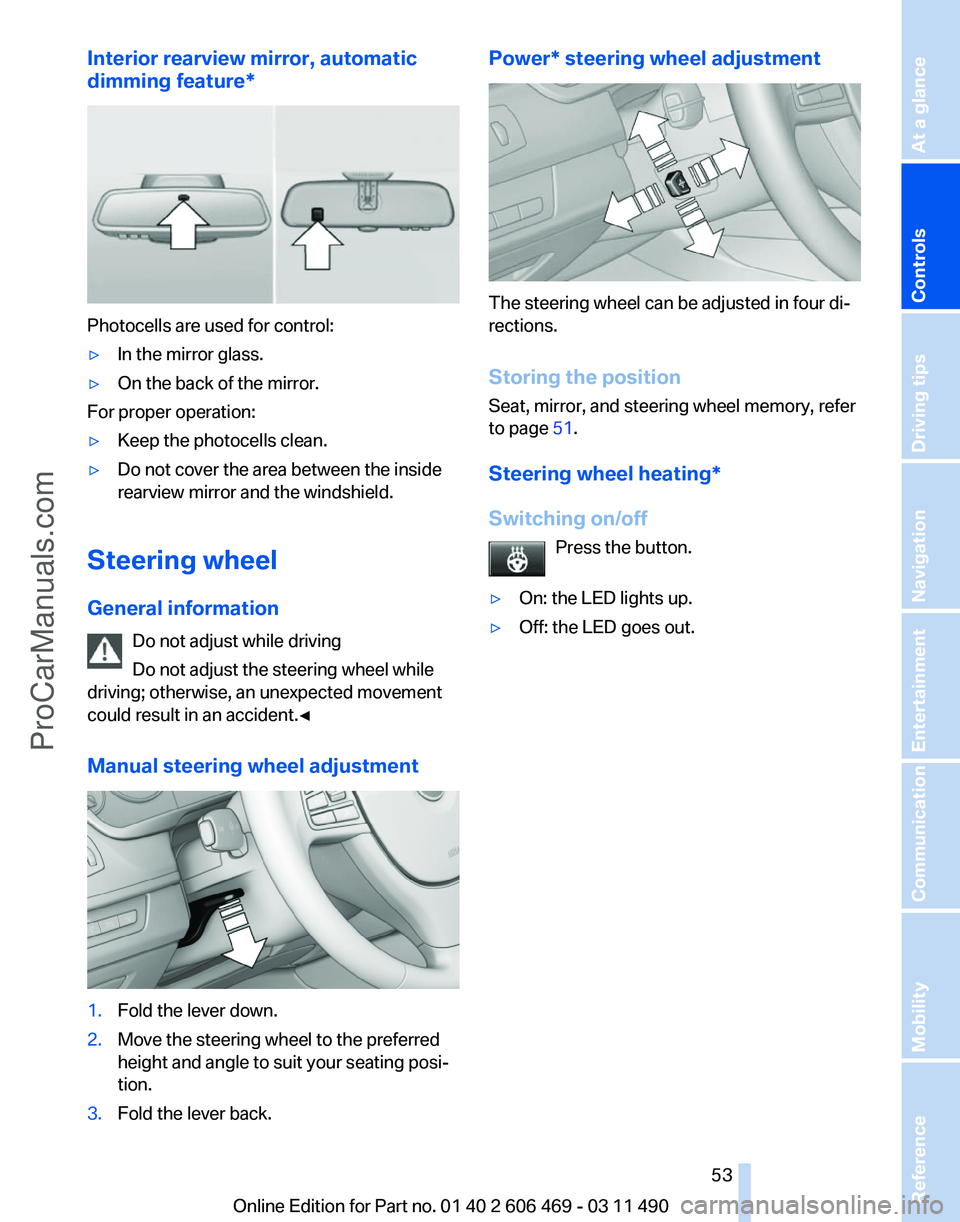
Interior rearview mirror, automatic
dimming feature
*Photocells are used for control:
‚Ė∑
In the mirror glass.
‚Ė∑ On the back of the mirror.
For proper operation:
‚Ė∑ Keep the photocells clean.
‚Ė∑ Do not cover the area between the inside
rearview mirror and the windshield.
Steering wheel
General information Do not adjust while driving
Do not adjust the steering wheel while
driving; otherwise, an unexpected movement
could result in an accident.‚óÄ
Manual steering wheel adjustment 1.
Fold the lever down.
2. Move the steering wheel to the preferred
height and angle to suit your seating posi‚Äź
tion.
3. Fold the lever back. Power* steering wheel adjustment
The steering wheel can be adjusted in four di‚Äź
rections.
Storing the position
Seat, mirror, and steering wheel memory, refer
to page
51.
Steering wheel heating
*
Switching on/off Press the button.
‚Ė∑ On: the LED lights up.
‚Ė∑ Off: the LED goes out. Seite 53
53Online Edition for Part no. 01 40 2 606 469 - 03 11 490
Reference Mobility Communication Entertainment Navigation Driving tips
Controls At a glance
ProCarManuals.com
Page 58 of 304
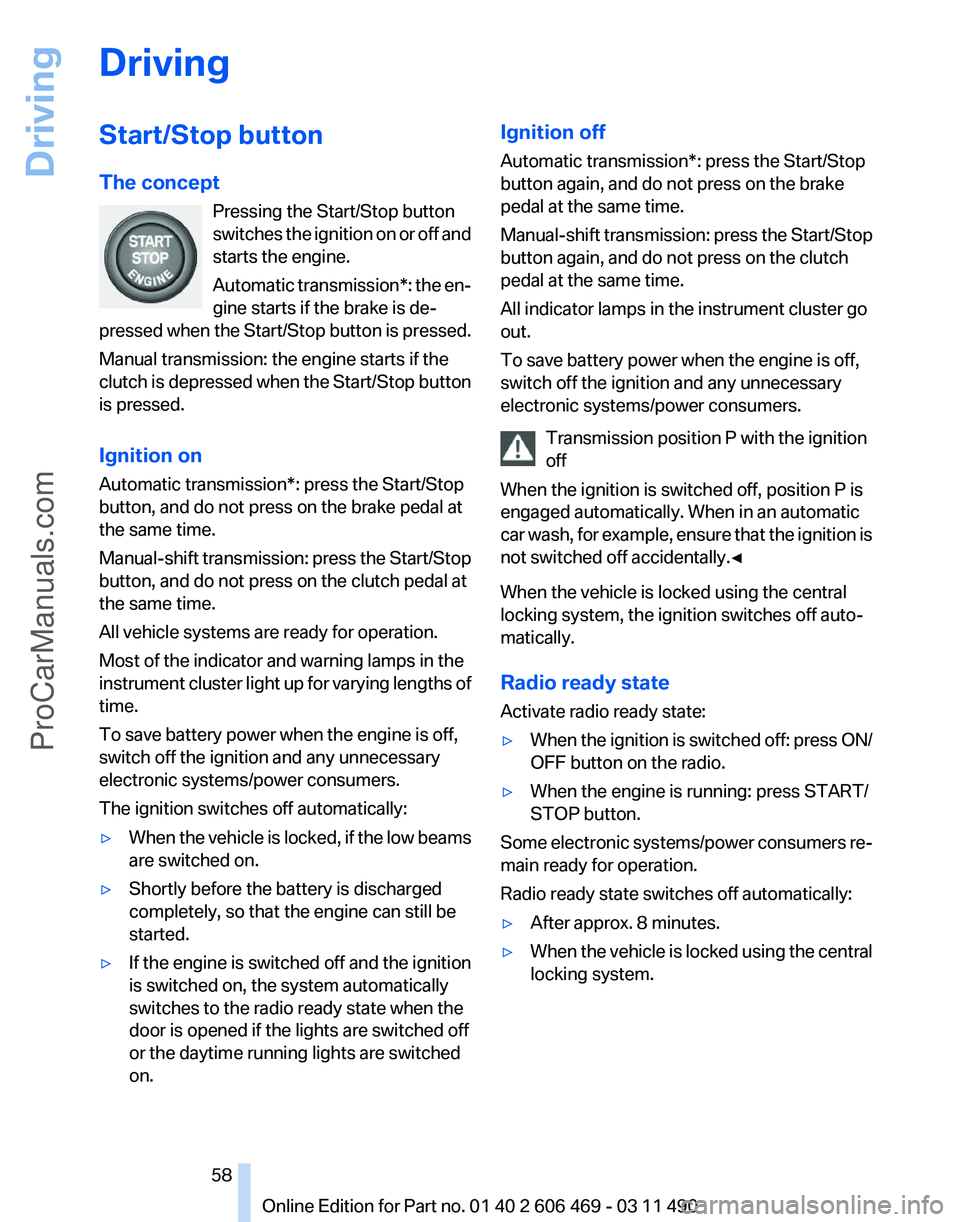
Driving
Start/Stop button
The concept
Pressing the Start/Stop button
switches
the ignition on or off and
starts the engine.
Automatic transmission*: the en‚Äź
gine starts if the brake is de‚Äź
pressed when the Start/Stop button is pressed.
Manual transmission: the engine starts if the
clutch is depressed when the Start/Stop button
is pressed.
Ignition on
Automatic transmission*: press the Start/Stop
button, and do not press on the brake pedal at
the same time.
Manual-shift transmission: press the Start/Stop
button, and do not press on the clutch pedal at
the same time.
All vehicle systems are ready for operation.
Most of the indicator and warning lamps in the
instrument cluster light up for varying lengths of
time.
To save battery power when the engine is off,
switch off the ignition and any unnecessary
electronic systems/power consumers.
The ignition switches off automatically:
‚Ė∑ When the vehicle is locked, if the low beams
are switched on.
‚Ė∑ Shortly before the battery is discharged
completely, so that the engine can still be
started.
‚Ė∑ If the engine is switched off and the ignition
is switched on, the system automatically
switches to the radio ready state when the
door is opened if the lights are switched off
or the daytime running lights are switched
on. Ignition off
Automatic transmission*: press the Start/Stop
button again, and do not press on the brake
pedal at the same time.
Manual-shift
transmission: press the Start/Stop
button again, and do not press on the clutch
pedal at the same time.
All indicator lamps in the instrument cluster go
out.
To save battery power when the engine is off,
switch off the ignition and any unnecessary
electronic systems/power consumers.
Transmission position P with the ignition
off
When the ignition is switched off, position P is
engaged automatically. When in an automatic
car wash, for example, ensure that the ignition is
not switched off accidentally.‚óÄ
When the vehicle is locked using the central
locking system, the ignition switches off auto‚Äź
matically.
Radio ready state
Activate radio ready state:
‚Ė∑ When the ignition is switched off: press ON/
OFF button on the radio.
‚Ė∑ When the engine is running: press START/
STOP button.
Some electronic systems/power consumers re‚Äź
main ready for operation.
Radio ready state switches off automatically:
‚Ė∑ After approx. 8 minutes.
‚Ė∑ When the vehicle is locked using the central
locking system. Seite 58
58 Online Edition for Part no. 01 40 2 606 469 - 03 11 490
Driving
ProCarManuals.com
Page 60 of 304
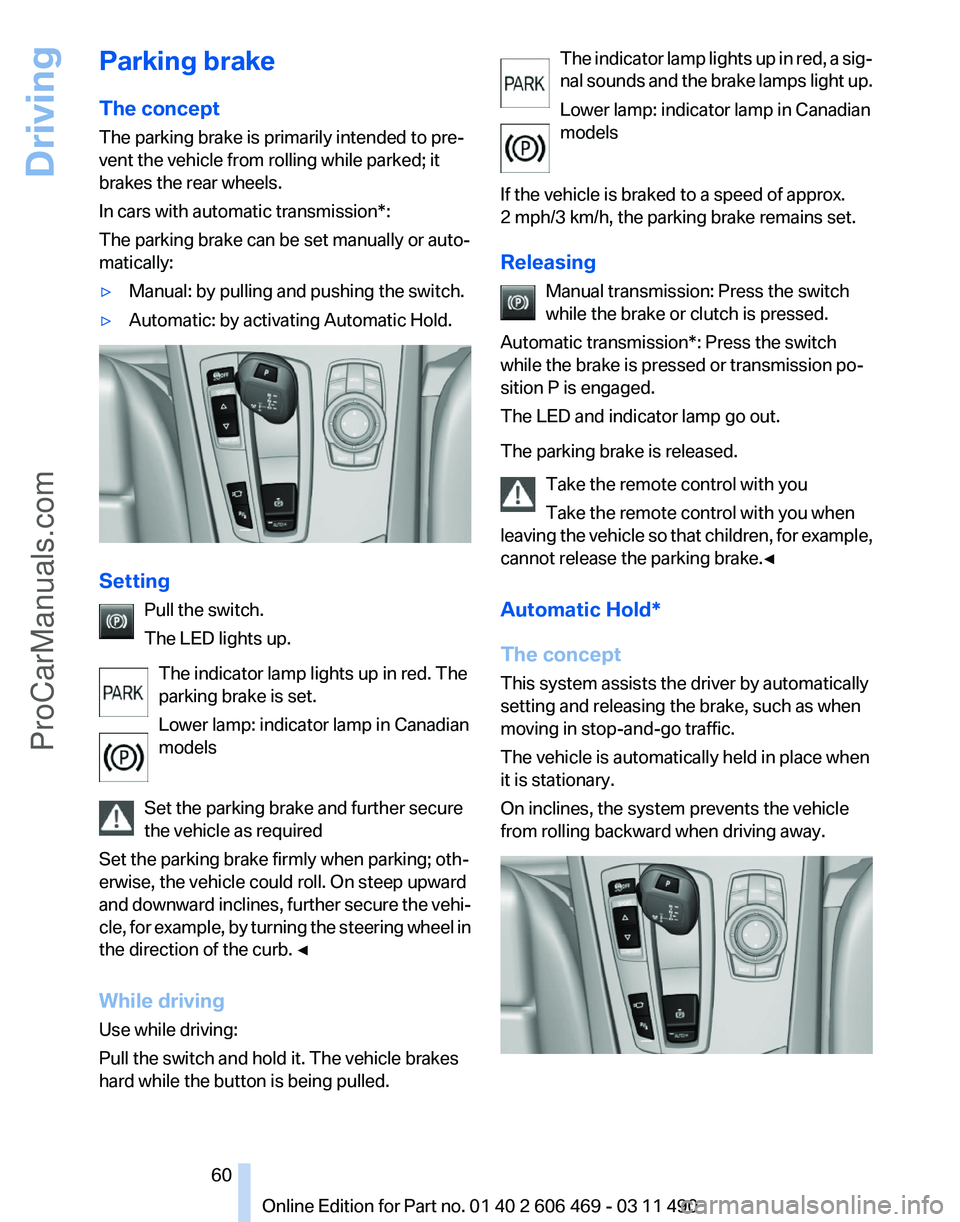
Parking brake
The concept
The parking brake is primarily intended to pre‚Äź
vent the vehicle from rolling while parked; it
brakes the rear wheels.
In cars with automatic transmission*:
The parking brake can be set manually or auto‚Äź
matically:
‚Ė∑
Manual: by pulling and pushing the switch.
‚Ė∑ Automatic: by activating Automatic Hold. Setting
Pull the switch.
The LED lights up.
The indicator lamp lights up in red. The
parking brake is set.
Lower lamp: indicator lamp in Canadian
models
Set the parking brake and further secure
the vehicle as required
Set the parking brake firmly when parking; oth‚Äź
erwise, the vehicle could roll. On steep upward
and
downward inclines, further secure the vehi‚Äź
cle, for example, by turning the steering wheel in
the direction of the curb. ‚óÄ
While driving
Use while driving:
Pull the switch and hold it. The vehicle brakes
hard while the button is being pulled. The indicator lamp lights up in red, a sig‚Äź
nal
sounds and the brake lamps light up.
Lower lamp: indicator lamp in Canadian
models
If the vehicle is braked to a speed of approx.
2 mph/3 km/h, the parking brake remains set.
Releasing Manual transmission: Press the switch
while the brake or clutch is pressed.
Automatic transmission*: Press the switch
while the brake is pressed or transmission po‚Äź
sition P is engaged.
The LED and indicator lamp go out.
The parking brake is released.
Take the remote control with you
Take the remote control with you when
leaving the vehicle so that children, for example,
cannot release the parking brake.‚óÄ
Automatic Hold*
The concept
This system assists the driver by automatically
setting and releasing the brake, such as when
moving in stop-and-go traffic.
The vehicle is automatically held in place when
it is stationary.
On inclines, the system prevents the vehicle
from rolling backward when driving away. Seite 60
60 Online Edition for Part no. 01 40 2 606 469 - 03 11 490
Driving
ProCarManuals.com